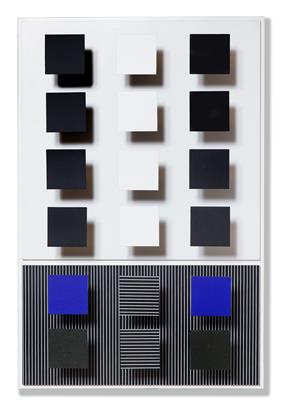Jesús Rafael Soto *

(Ciudad BolÍvar 1923–2005 Paris)
Tres pequeñas columnas, 1992, signed, dated and titled on the reverse, acrylic on wood and metal, 78 x 52 x 16,5 cm
This work is registered in the Atelier Soto, Paris, under no. 21949066 and is accompanied by a photo certificate signed by Hélène Soto. It will be included in the catalogue raisonné currently being prepared.
Provenance:
Galerie Denise René, Paris (label on the reverse)
European Private Collection
“The immaterial is the sensory reality of the universe.
Art is the sensory knowledge of the immaterial. To become conscious of the immaterial in its state of pure structure, is to make the final leap towards the absolute.”
Jesús Rafael Soto
The starting point of Jesús Rafael Soto’s art is pure abstraction derived from Mondrian, Malevich and Kandinsky. While continuing the use of coloured geometric shapes, the artist departs from abstract art in choosing to introduce elements in his works that create kinetic optical effects that challenge the viewer to a game of perception. For Soto and all exponents of programmed art, the artist is no longer an irrational and instinctive romantic who values gesture, matter and a desire for the expression of the ego. All these characteristics are considered to be attributes of an outdated art. Instead, the artist is a technician, a scientist, a political activist who knows how to combine art with society.
Through the mastery of science and technology, whose strong experimental matrix and empirical verification it makes its own, programmed art analyses reality and studies human perception, thus psychologically involving the spectator. The works are visually stimulating through clear and essential communication and the public is therefore called to interact personally with the work through the artist’s transformation of a flat surface into a three-dimensional space.
“No artist today,” says Soto, “can ignore space-time.” His interest in movement does not focus on ways to attribute motion to his creation, but rather to elicit an optical shifting effect in the viewer’s perception through an interaction between shapes, colours and space.
In his early works, Soto achieved movement through the repetition and superimposition of two-dimensional elements on the image surface; in later works, he used colour instead, creating illusory spaces through the contrast between monochromatic surfaces. These visual ambiguities are enhanced by metal wires, pieces of wood, suspended bars and, at a later date, by floating lines which, when subjected to an occurrence as natural as the movement of air, vibrate in relation to the patterns that form the background.
In ‘Tres Pequeñas columnas’, same-size squares are anchored on a flat surface through a metal support. The observer’s visual perception is deceived by the play of surfaces that seem to sway until they dematerialise. In contrast to vibrations made with thin metal rods, which lose their individual character and seem almost to disappear before the striped background, here the squares maintain their form. The physical distance between them and the support remains difficult to gauge, and the squares appear to float in space. Although it is an oscillation, a movement, it is contained, obtained not by an engine as Duchamp had done, but through a controlled vibration.
Soto’s emphasis on continuous, dynamic optical transformation rather than the art object itself is in keeping with his goal of stressing the concept of dematerialisation.
Esperto: Alessandro Rizzi
 Alessandro Rizzi
Alessandro Rizzi
+39-02-303 52 41
alessandro.rizzi@dorotheum.it
24.06.2020 - 16:00
- Prezzo realizzato: **
-
EUR 125.300,-
- Stima:
-
EUR 80.000,- a EUR 120.000,-
Jesús Rafael Soto *
(Ciudad BolÍvar 1923–2005 Paris)
Tres pequeñas columnas, 1992, signed, dated and titled on the reverse, acrylic on wood and metal, 78 x 52 x 16,5 cm
This work is registered in the Atelier Soto, Paris, under no. 21949066 and is accompanied by a photo certificate signed by Hélène Soto. It will be included in the catalogue raisonné currently being prepared.
Provenance:
Galerie Denise René, Paris (label on the reverse)
European Private Collection
“The immaterial is the sensory reality of the universe.
Art is the sensory knowledge of the immaterial. To become conscious of the immaterial in its state of pure structure, is to make the final leap towards the absolute.”
Jesús Rafael Soto
The starting point of Jesús Rafael Soto’s art is pure abstraction derived from Mondrian, Malevich and Kandinsky. While continuing the use of coloured geometric shapes, the artist departs from abstract art in choosing to introduce elements in his works that create kinetic optical effects that challenge the viewer to a game of perception. For Soto and all exponents of programmed art, the artist is no longer an irrational and instinctive romantic who values gesture, matter and a desire for the expression of the ego. All these characteristics are considered to be attributes of an outdated art. Instead, the artist is a technician, a scientist, a political activist who knows how to combine art with society.
Through the mastery of science and technology, whose strong experimental matrix and empirical verification it makes its own, programmed art analyses reality and studies human perception, thus psychologically involving the spectator. The works are visually stimulating through clear and essential communication and the public is therefore called to interact personally with the work through the artist’s transformation of a flat surface into a three-dimensional space.
“No artist today,” says Soto, “can ignore space-time.” His interest in movement does not focus on ways to attribute motion to his creation, but rather to elicit an optical shifting effect in the viewer’s perception through an interaction between shapes, colours and space.
In his early works, Soto achieved movement through the repetition and superimposition of two-dimensional elements on the image surface; in later works, he used colour instead, creating illusory spaces through the contrast between monochromatic surfaces. These visual ambiguities are enhanced by metal wires, pieces of wood, suspended bars and, at a later date, by floating lines which, when subjected to an occurrence as natural as the movement of air, vibrate in relation to the patterns that form the background.
In ‘Tres Pequeñas columnas’, same-size squares are anchored on a flat surface through a metal support. The observer’s visual perception is deceived by the play of surfaces that seem to sway until they dematerialise. In contrast to vibrations made with thin metal rods, which lose their individual character and seem almost to disappear before the striped background, here the squares maintain their form. The physical distance between them and the support remains difficult to gauge, and the squares appear to float in space. Although it is an oscillation, a movement, it is contained, obtained not by an engine as Duchamp had done, but through a controlled vibration.
Soto’s emphasis on continuous, dynamic optical transformation rather than the art object itself is in keeping with his goal of stressing the concept of dematerialisation.
Esperto: Alessandro Rizzi
 Alessandro Rizzi
Alessandro Rizzi
+39-02-303 52 41
alessandro.rizzi@dorotheum.it
|
Hotline dell'acquirente
lun-ven: 10.00 - 17.00
kundendienst@dorotheum.at +43 1 515 60 200 |
| Asta: | Arte contemporanea I |
| Tipo d'asta: | Asta in sala |
| Data: | 24.06.2020 - 16:00 |
| Luogo dell'asta: | Wien | Palais Dorotheum |
| Esposizione: | 18.06. - 24.06.2020 |
** Prezzo d'acquisto comprensivo di tassa di vendita e IVA
Non è più possibile effettuare un ordine di acquisto su Internet. L'asta è in preparazione o è già stata eseguita.
